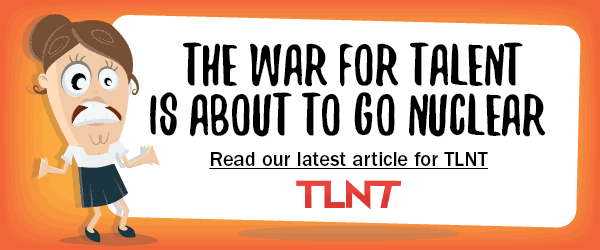There's no way to lose with benefits, right?
You're paying employees competitive salaries. The culture at the office is pretty good, too.
So, benefits are like a nice little additional touch. They're like a cherry on top of a great sundae.
Some people love the cherry, but most are there for what's underneath it.
Here's the thing: cherries are getting to be more important to people, and not having quality cherries on your sundae might actually be ruining your treat.
Or, to ditch the sundae analogy: benefits are becoming very important, and if they're not managed properly, they can crush the souls of your employees and send them off to eat sundaes with some other company.
Check out these nine potential drawbacks to benefits and perks that can cause employees to feel bitter, resentful, and/or angry.  1. They're Generic
1. They're Generic
Too many businesses stick with the standards (health, PTO, 401k) and maybe throw in a performance bonus here and there. They might assume they're making up for a lack of benefits with salary, but a good employee can find a comparable salary elsewhere.
Employees earn a 5.2% pay increase on average when changing jobs (Glassdoor)
What's really harmful about sticking with the basics is the missed opportunity to be creative in showing how you value your employees.
The underlying message behind corporate perks is that the company is willing to invest more in employees than just a salary. The company is willing to do what others don't because their employees aren't like other employees.
2. They're Irrelevant
Leading with a 401k matching program is nice but doesn't do much for your older workers, who are closer to cashing out than buying in. Same thing with tuition reimbursement, paid day care, or elder care benefits.
Those are all good and valuable, but don't rely on any one of them to lead your charge, unless appealing to that generation is your top priority.
Diversify your offerings to meet as many needs as possible and use voluntary options on occasion, but focus your benefits on tangible relevance across all employees. This means areas like stress reduction, work/life balance, and helping employees save money.
If possible, even let employees build their own benefits package.
88% of employees like the idea of having choices to customize their benefit packages (Sun Life)
3. They're Not Solving Problems
An open bar full of craft beer sounds awesome and will surely bring all the boys to your yard.
Over time lavish perks like these fall by the wayside because they don't really serve a practical application or meet a need people have.
Eventually, many employees will look at frilly perks and wonder why that money can't be spent on student loan payments or even raises.
53% of workers say they would prefer a salary increase over any other perk (Teem)
4. They're Hidden
How many benefits can your typical employee name by heart? Would they be surprised that you offered telehealth or an EAP?
Chances are you have some great, useful stuff to offer. You probably even put together a nice section about it in your handbook.
36% of employees, and 23% of Millennials, don't know where their benefit handbooks are anymore (GuideSpark)
Benefits and perks need to be promoted. You can't just pump them up at open enrollment then ignore them the rest of the year.
5. Usage is Discouraged
At my last job, the boss installed a ping pong table and Nintendo Wii, and was so proud of this advancing workplace culture. The boss then proceeded to badger anyone caught using said amenities.
"You look like you're having fun; it'd be a lot more fun if you could wrap up that Thompson proposal."
"Oh, Mario Kart. I'm guessing you've completed everything on your plate?"
"You've been playing a lot of ping pong lately. Do you need more work to do?"
Don't be like that boss.
Put in great, useful perks and let people use them as they see fit.
One perk many companies are terrible at allowing? Time off.
57% of dissatisfied employees say no one encourages them or supports them taking PTO; just 18% of those very satisfied feel the same (Fierce)
6. They're Not Available to All
It's understood by most that executives and top management are going to have some special perks that the regular workers don't. But when peers gain access to certain amenities that aren't there for everyone else, it's going to foment contempt.
Say your marketing department rents out a theater for new movies once a month. That's going to get the IT people hot and bothered when they can't catch the next superhero megaflick on opening night.
23% of companies offer company purchased tickets to events such as cultural proceedings, sporting events or theme parks (SHRM)
Make sure those opportunities are available to everyone in an organization, or that everyone has an equivalent perk available.
Maybe IT can't go to the movies, but their daily spa treatments sure ease the pain.
7. They're Trying to Cover Up a Bad Culture
Before adding a benefit, start by asking yourself why you need it. If the answer to that question is, "It'll make putting up with angry managers more palatable," then save your money.
Go spend it on training for management, or use it to buy out your executive team, maybe.
Put yourself in the position of an employee who hasn't seen a pay raise in a long time. A climbing wall is only going to make that employee question the company's financial priorities.
8. They're Spammy
That benefit you're giving employees that costs you nothing or was super cheap? If it isn't a legitimate voluntary benefit from an established vendor, it's probably doing some bad stuff behind the scenes.
We see this frequently in the world of employee discount programs. Some providers give away their discount content for free or super cheap. How can they do that? Well, their deals are either scraped from public sites (which is a bad, bad practice in our industry) or they're publicly-available affiliate offers that generate bits of revenue on each transaction.
In other words, these companies are turning their employees into a revenue-generation machine for a vendor - and calling it a benefit!
Be thorough with your vendors, and make sure they're as dedicated to your employees are you are.
41% of employees are concerned about infrequent communication about benefits (Health Advocate)
9. They're Too Complicated
Benefits communication isn't just about making sure people know they're available. It's about helping them understand how to use and get the maximum value from the benefits.
Unfortunately, most people have no idea how these things work.
Just 7% of employees can successfully define four basic health insurance concepts: plan premium, deductible, co-insurance and out-of-pocket maximum (United Healthcare)
Benefits are evolving and new services like telehealth have slightly different premiums and copays. HSAs, FSAs, HRAs, cafeteria plans...what's the difference in those?
Take the time to explain details to employees as best as you can. Yes, they're easily distracted and open enrollment presentations are like presenting to zombies. Put the information out there as clearly as you can, then make sure everyone knows you're the expert to talk to moving forward. Eventually, they're going to be interested, and they're going to have questions.
Or, conversely, they're going to try to use something before understanding how to get the most out of it, and have their souls crushed upon finding out that $500 in their FSA is lost when the new year comes.
Benefits Gone Bad
In each of these instances the outcome is the opposite of what's intended.
Instead of pride, employees feel resentment. Instead of development, employees are bitter about missed opportunities. Instead of usage, the benefits are pushing employees to apply elsewhere.
Never assume that the mere presence of benefits is enough, even if your salaries are competitive. You don't have to match the ridiculousness of the tech companies in Silicon Valley, but you do have an obligation to put together a relevant, useful package of perks and benefits.
Take your benefits seriously, and evaluate them with the same rigor any other investment the company makes. Set goals, invest time and energy, and constantly push for more employee feedback.
Otherwise, what should be a nice extra somethin' somethin' could turn into a soul crushing portal to employment with someone else.




